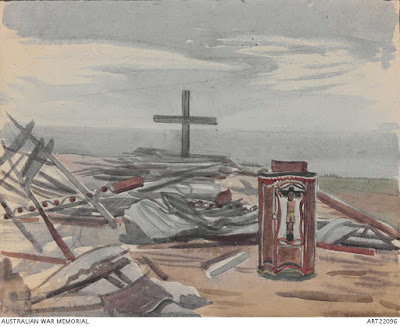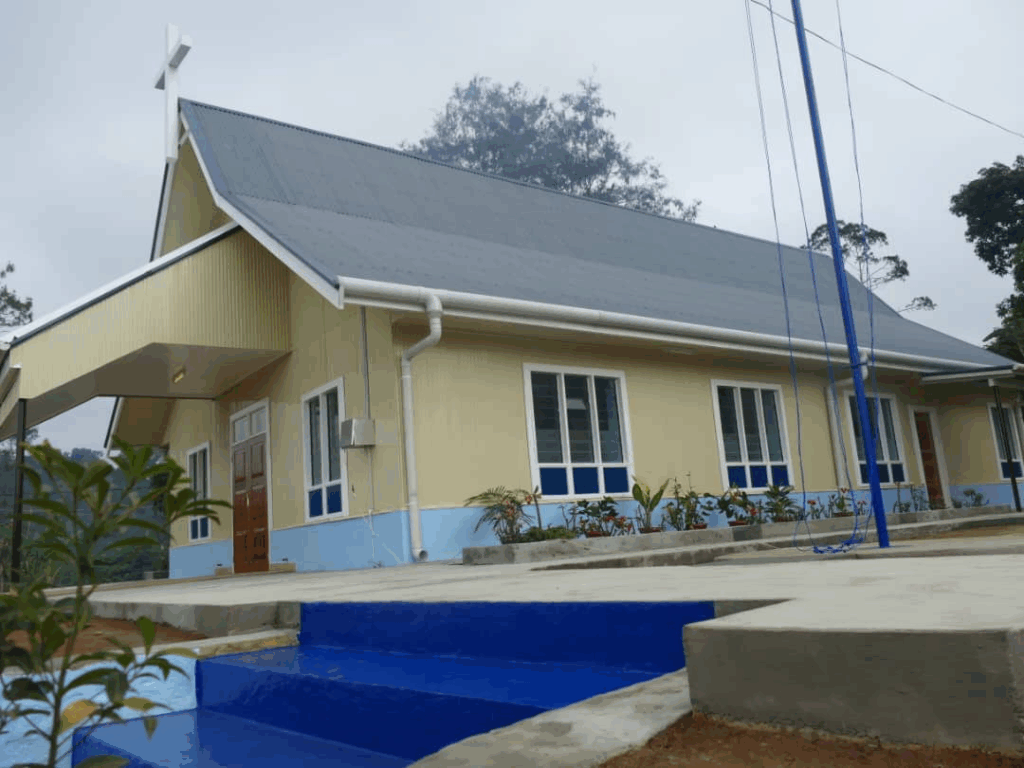The Cross and the Pulpit: A Testament of Endurance
Amid the smoke and ashes of war, two objects stood tall: the cross and the pulpit. Everything else at the Sattelberg Mission Station—its homes, classrooms, and the grand timber church—had been reduced to rubble during a brutal World War II assault. Yet the cross remained, upright and untouched. The pulpit, ornately carved from the trunk of a great tree, lay amid the debris, but was still intact. These were not simply religious artifacts. They were sacred survivors. Silent, yet loudly proclaiming a message that war could not silence: Hope endures. Faith withstands. Love triumphs.
They stood then—and still stand today—as visible signs of what it means to be “the salt of the earth and the light of the world” (Matthew 5:13–14). They call out to a wounded world: though fire may fall and nations may rage, God’s Word and witness shall not be destroyed.
From Ashes to Hope: The Aftermath of World War II
This is an inspiring story of Sattelberg Mission Station that many Lutheran faithful do not know.

Many Lutheran followers in Papua New Guinea understand the deep spiritual and historical significance of the Sattelberg Mission Station in Finschhafen. It is often regarded as the cradle of Lutheran missions along the Morobe coastline. From this hilltop station, early local evangelists were trained, commissioned, and sent forth to cross the sea to Lae, brave the Markham River, and traverse the vast and rugged Markham Valley, eventually climbing into the highlands and reaching as far as the Southern Highlands. This mission movement began during the early period of German colonial administration in New Guinea—before the upheavals brought by World War II and major colonial administrative changes reshaped the region.
Yet many may not realize that Sattelberg was at the very center of a major military campaign during World War II. In 1943, it became a stronghold of the Japanese forces and thus a key target in the Allied offensive. For eight days, Allied air raids and ground assaults pounded the hilltop in a bid to reclaim it. The peaceful mission station, once a beacon of faith and learning, was turned into a battlefield.
Amid this chaos, something truly awe-inspiring happened: though the church was reduced to rubble, only the cross and the pulpit stood untouched. Everything else—homes, timber buildings, sacred spaces—lay flattened or charred. But the cross, upright and strong, and the pulpit, carved with care and faith, remained. These were not just remnants of a building—they were divine testaments of endurance, proclaiming that while war destroys, faith survives.
This remarkable moment was immortalized in a painting by Nora Heysen, Australia’s first official female war artist. Appointed in 1943, she was sent to the Pacific to document the war. After the fighting at Sattelberg had ended in November 1943, Nora visited the bombed site. Her painting captures the aftermath—a church reduced to ash and splinters, yet the cross and pulpit still standing, defying the violence that had tried to erase them.
During the Japanese occupation, missionaries had been expelled, and the mission station militarized. The Allied victory on 24 November 1943 marked a turning point, but it came at great cost. The caption of Heysen’s work reads: “The timber remains of the church at Sattelberg Mission; only the cross and the pulpit are left standing.”
A contemporary article from Australia’s Trove archive described the haunting scene:
“REMAINS OF CHURCH – A heap of timber, a few curiously carved figures, and a sturdy cross still standing and still undamaged was once the mission church... Lying among the timber was a gaudy pulpit carved from the trunk of a great tree and ornamented with bas reliefs...”
These surviving symbols—the cross and the pulpit—speak louder than any sermon. They are not merely wooden artifacts; they are sacred declarations that love is stronger than hate, that light shines even through the thickest darkness, and that God’s message endures even under fire.
Nora Heysen’s painting reminds us that though bombs can shatter structures, they cannot shatter hope.
Today, a new church stands at Sattelberg. And within its walls are preserved the very same cross and pulpit that defied the flames of war. Restored and revered, they remind all who visit that even when all seems lost, God’s Word and witness remain unshaken.
Sattelberg is more than a place of memory—it is a living testimony. It teaches us that even when destruction rains from the skies, the foundation of what is good, just, and true can and will endure.
From that enduring truth, we rebuild. And from the ashes, we draw renewed hope.
In the words of Jesus in Matthew 5:13–14 (NIV):
"You are the salt of the earth... You are the light of the world. A town built on a hill cannot be hidden."
This powerful reminder calls us, as members of the Evangelical Lutheran Church of Papua New Guinea (ELCPNG), to live as that enduring salt and shining light, even in the face of adversity.
As we approach meaningful milestones—the 139th Anniversary of Lutheran Mission in PNG on 12 July 2025, the 50th Anniversary of ELCPNG as an organization on 11 July 2026, and the 50th Anniversary of Papua New Guinea’s Independence on 16 September 2025—the ELCPNG Synod 2024 theme, “Salt of the Earth, Light of the World,” gains even deeper meaning. These commemorations are not just historical—they are calls to mission, reminding us that our legacy is not in buildings, but in how we carry the light forward.
Let the Cross and Pulpit of Sattelberg remind us all:
Faith may be tested, but it will never be defeated.
And just as these symbols stood tall through fire and rubble, so too must the Church stand tall as the prophetic voice in the nation—a voice that speaks truth in times of confusion, conscience in times of compromise, and hope in times of despair.
The Church’s mission does not end at the pulpit. Like Christ, we must engage with systems, policies, cultures, and structures—exposing injustice, preserving truth, and bringing light to dark places. To be salt and light is to act boldly—for the environment, for the poor, for the voiceless.
In today’s dark world, the Church must rise from the ashes of complacency and be what it was always meant to be:
"A town on a hill that cannot be hidden. A voice of conscience. A bearer of hope."


